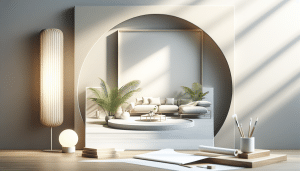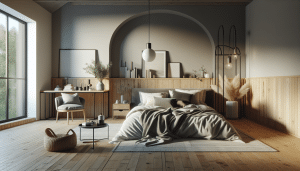Simple Decluttering Tricks That Transform Your Space
Samantha Lee September 9, 2025
Uncover surprisingly effective decluttering tricks used by design experts and everyday organizers. This guide explores practical techniques to simplify your home, boost comfort, and create peaceful spaces while weaving in easy lifestyle habits you can try for less stress.
Understanding Why Clutter Impacts Mood and Productivity
Walk into any cluttered room and there’s an instant change in mood. Some research reveals that clutter not only overwhelms the senses but can increase stress and even lower productivity. Visual disorganization takes up valuable mental energy because your brain constantly sorts through distractions. Even beloved collections can become tiring when there’s no order. If you’ve recently felt easily distracted or out of sorts, excess clutter in your living space might be quietly to blame—many discover that tidying up even a single surface can bring noticeable relief and increased mental clarity. This connection is so well documented that many home design experts and psychologists recommend simple decluttering tricks to create supportive environments for both relaxation and focus. https://www.mayoclinic.org/healthy-lifestyle/adult-health/expert-answers/declutter/faq-20058339
Think about the last time you saw a tidy coffee table or a neat shelf. A minimalist room can invite calm and make it easier to unwind after a busy day. Many people learn that even quick daily maintenance—such as putting away a coat as soon as you walk in—builds a sense of control over your environment. You don’t have to become a full minimalist to benefit from these ideas. In fact, simply removing items that don’t serve a purpose or bring joy may clear space for other aspects of your life, like creativity, quality sleep, or time with loved ones. It’s fascinating how letting go of clutter opens up new feelings of freedom and opportunities for positive routines.
Science has revealed how homes filled with clutter can impact health and emotions. Messier environments are sometimes linked to a higher risk of anxiety and poorer sleep quality. Home organization isn’t just about appearances; it’s about supporting behavior change. For families, organized common areas may help children focus on homework and reduce family arguments. For individuals, a cleaner kitchen has even been linked to healthier eating. Decluttering is more than tidying, it’s a gentle lifestyle shift with big lifestyle payoffs. https://www.npr.org/sections/health-shots/2021/01/12/956324480/what-clutter-does-to-your-brain
Room-by-Room Decluttering Techniques That Actually Work
Each space in your home faces its own decluttering challenges. For living rooms, multi-use baskets or ottomans with storage help corral stray remotes, magazines, or kids’ toys in seconds. In kitchens, using clear containers or lazy Susans in pantry corners streamlines meal prep while keeping shelves neat. Bedrooms benefit from under-bed storage bins—great for off-season clothes or extra linens, making wardrobe rotations effortless. The real game changer is committing to small daily actions in each space. Regularly dedicating five to ten minutes to one room often does more than an hours-long cleaning spree, and it’s less overwhelming to maintain. https://www.goodhousekeeping.com/home/organizing/g3346/declutter-tips/
Bathrooms often overflow with rarely used products. Try implementing a “use it or lose it” rule: if you haven’t reached for something in several months, consider recycling it, donating it, or finding a new home for it. In closets, streamlined organization is all about categorizing and regularly reassessing what you truly wear. Imagine the ease of finding everything during busy mornings! Bedrooms stay more restful when bedside surfaces are cleared of clutter, limited to just a lamp, favorite book, or a cherished item. Kitchen areas thrive with labeled bins and drawer dividers, turning weekday meal prep into a stress-free ritual.
Entryways often become catchalls. Hooks installed at eye level keep bags and jackets off the floor, while shoe racks limit piles at the door. Don’t shy away from labeling cubbies or baskets for family members—organization expert Marie Kondo suggests clear zones encourage responsibility. If storage is tight, multipurpose furniture can serve as both decor and hidden organization. The secret is addressing each room’s unique patterns and pain points, so systems evolve with your routines rather than against them. Sometimes, just a few small changes can yield dramatic improvements in comfort and appearance. https://www.apa.org/topics/organization-tips
Easy Decluttering Habits for Sustainable Results
Lasting change often starts with micro-habits—tiny behaviors that add up. One powerful tip is the “one-in, one-out” habit: when you bring something new home, remove a similar item. This keeps accumulation in check without dramatic purges. Another great approach is five-minute resets, done at the end of each day or before guests arrive. Place items back where they belong quickly—soon it becomes second nature. For shared households, involving everyone with their own responsibilities ensures collective success. Even children delight in having their own labeled bins or hooks for favorite things.
Consider making decluttering part of weekly or monthly routines. “Donation day,” when the family fills a box with items no longer needed, can create a spirit of generosity and cooperation. Virtual clutter counts too—cleaning up digital photos or unsubscribing from emails can free up both time and digital space. Many discover that as these new habits stick, the stress caused by excess stuff gradually fades. Decluttering then becomes less about a big project and more a peaceful daily rhythm that supports how you want to live.
Another popular trick is attaching a positive habit to a decluttering task—pair ten minutes of sorting with uplifting music or an audiobook. This “habit stacking” makes the process enjoyable and something to anticipate rather than dread. For those who love pretty things, giving treasured items pride of place on a shelf or in a display box makes letting go of less-loved objects easier. By focusing on joy and simplicity rather than just removal, decluttering feels motivating and sustainable. This mindset shift is what leads to lasting transformation. https://www.verywellmind.com/how-to-declutter-your-mind-and-your-home-3144729
Organizational Tools and Storage Solutions That Save Time
Finding the best organizational tools can feel overwhelming, but a few clever basics work wonders in most homes. Stackable bins and modular shelving adapt to corners and closets of every size. Drawer dividers prevent small items like socks or utensils from tangling. Transparent containers reveal contents, ending the mystery of “what’s inside?” Rolling carts can double as craft stations or mobile offices for those needing flexible spaces, while wall-mounted baskets free up valuable floor area. These tools aren’t about perfection or aesthetics; they’re about making everyday routines smoother and more joyful.
Digital solutions also play a significant role. Apps now organize everything from closet inventory to grocery shopping lists, and simple smartphone reminders help form new habits. Home inventory apps track what you have and inspire more mindful shopping. For paper clutter, consider going paperless with digital bill pay and cloud-based document storage. This not only reduces physical clutter but also saves time when searching for important information. Technology, when used thoughtfully, supports a clutter-free lifestyle amid busy schedules.
For families or roommates, communal organization centers—like shared bulletin boards or baskets for incoming mail—encourage cooperation and reduce “missing item” confusion. Some people invest in furniture with hidden storage, such as beds with drawers or benches doubling as toy chests. Embrace solutions that align with your space, style, and daily routines. There’s no single right answer—experiment until you discover what makes maintaining order feel nearly effortless. Ultimately, the goal is creating a home that supports more of what you love and less of what distracts. https://www.nytimes.com/guides/smarterliving/how-to-declutter
The Emotional Side of Decluttering and Letting Go
Decluttering is rarely just about stuff. Items in our homes hold memories, aspirations, or even guilt (“I should use this someday”). That’s why letting go can trigger emotions—ranging from relief to sadness. Experts suggest starting with objects you’re less attached to, like old magazines or duplicate kitchen tools. Every success makes the next step easier, as progress builds confidence. For sentimental objects, try taking photos or creating a memory box instead of keeping everything. Acknowledge the memories, then allow yourself to make space for your current needs.
The psychological freedom that comes with releasing unneeded things is powerful. Studies find that as clutter reduces, many people report feeling lighter, more optimistic, and even experience improved relationships. The act of sorting and choosing becomes a visible representation of self-care. It isn’t about perfection, but about giving yourself permission to live with greater intention. Donating useful but no-longer-needed items can add another layer of satisfaction—knowing your belongings might serve someone else well.
If big decluttering projects feel overwhelming, break tasks into tiny pieces—one shelf at a time, one small box per weekend. Celebrate small wins: every cleared corner is progress. The emotional boost from organized spaces creates momentum for making additional positive life changes. Decluttering is a journey, and its rewards extend far beyond physical tidiness, touching nearly every aspect of daily living. https://greatergood.berkeley.edu/article/item/how_to_declutter_your_life_and_mind
When to Seek Support and Decluttering Inspiration
Sometimes, professional organizers or support groups can jump-start stalled projects. For individuals facing hoarding tendencies or who struggle letting go, mental health professionals can offer compassion and proven strategies. Online forums and social media challenge groups provide motivation and new ideas to keep the process fresh and encouraging. Reading personal stories or watching transformation videos may spark the motivation needed to begin.
Decluttering inspiration is everywhere: in books, on TV shows, and in community workshops. Many municipalities offer recycling days or donation events, making it easy to give unused items a second life. If you’re not sure where to start, consider a “12-12-12” challenge—find twelve items to throw away, twelve to donate, and twelve to return to their proper spot. Even small steps, repeated over time, create momentum and lasting change. You’re not alone in the journey toward a clearer, calmer home—even experts struggled when starting out.
Your unique routines and tastes shape the path to success. Don’t worry about reaching minimalism or competing with beautiful magazine spreads. Focus instead on what feels right for you and the people you live with. Each step toward a tidier space is an investment in comfort and peace. Over time, these routines become second nature and can inspire others in your circle to embark on their own transformation. Celebrate the wins, learn from the setbacks, and keep moving forward. https://www.nimh.nih.gov/health/topics/hoarding-disorder
References
1. Mayo Clinic Staff. (n.d.). Decluttering: Do you have too much stuff? Retrieved from https://www.mayoclinic.org/healthy-lifestyle/adult-health/expert-answers/declutter/faq-20058339
2. NPR. (2021). What Clutter Does to Your Brain. Retrieved from https://www.npr.org/sections/health-shots/2021/01/12/956324480/what-clutter-does-to-your-brain
3. Good Housekeeping. (n.d.). 100 Decluttering Tips That Will Help You Organize Your Home. Retrieved from https://www.goodhousekeeping.com/home/organizing/g3346/declutter-tips/
4. American Psychological Association. (n.d.). Organization Tips. Retrieved from https://www.apa.org/topics/organization-tips
5. Verywell Mind. (2021). How to Declutter Your Mind and Your Home. Retrieved from https://www.verywellmind.com/how-to-declutter-your-mind-and-your-home-3144729
6. National Institute of Mental Health. (n.d.). Hoarding Disorder. Retrieved from https://www.nimh.nih.gov/health/topics/hoarding-disorder







